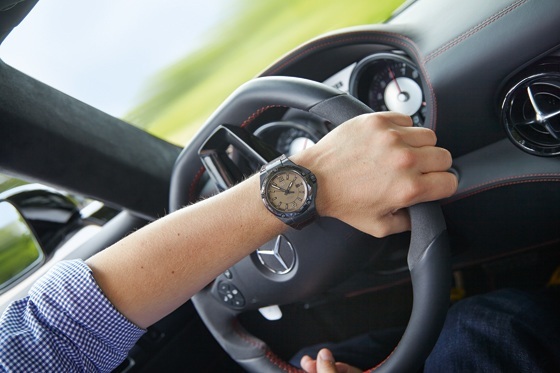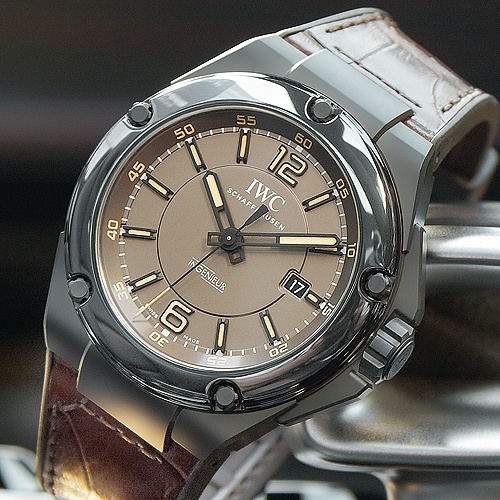We pull over for a quick break in a shady spot, and this gives us a chance to take a closer look at the strap and clasp, where we discover a shortcoming, at least in warm weather: the seam wicks perspiration from the wrist to the strap’s prettily grained leather inlay, which causes the inlay to darken along its edges. The buckle is pronged and made of matte titanium rather than ceramic, but it’s nevertheless a good match for the watch. The buckle is easy to use and doesn’t feel unduly thick, thanks to the beveled slits in the strap.
The Ingenieur’s dial is easy to read. The indices and the two numerals ensure adequate orientation and the double-digit minutes numerals on the flange above the hour indices are surprisingly helpful. You can tell the time quickly, even while you’re driving through a tunnel, although the dial’s luminosity weakens if the watch is in the dark for a long time.
At the moment, though, in the blazing sunshine, there’s no need to worry about luminosity. We’ve found the switch to operate the car’s adaptive adjustable suspension. We choose “sport plus” and steer through the curves at breakneck speed. The suspension in this setting is so hard that the Ingenieur is challenged to cushion the impacts with its serpentine rotor bridge, designed to absorb shocks. We’re also pleased that despite this watch’s diameter of 46 mm, its strap clings as closely and as comfortably to our wrist as does the racing seat of the SLS to its driver. Nothing presses uncomfortably against the wrist, and the strap’s rubber inner surface feels as soft and supple as the roadster’s Alcantara upholstery.

Unlike earlier Ingenieur models, this one does not incorporate a soft-iron Faraday cage to protect the movement from magnetic fields. Leaving it out enabled the designers to make the watch thinner and to incorporate a transparent back. Given the lack of protection, we were glad that the lateral loudspeakers of the SLS’s sound system are installed somewhat higher up, where the watch won’t come too close to them when you rest your forearm on the armrest.
The watch’s styling alludes to the Ingenieur SL by Gérald Genta from the 1970s, a sporty luxury watch with an integrated metal bracelet and five holes on its bezel. With the collection’s 2005 relaunch, the case took on a more angular shape and the numerals on the dial their current look. Crown protectors have been a familiar feature since 2009, when they appeared on the Ingenieur Mission Earth. The screws on the bezel, which replace the five holes, are new. They’re not merely decorative: they penetrate all the way through to affix the bezel and the back to the middle piece of the case. Their unusually shaped heads through to affix the bezel and the back to the middle piece of the case. Their unusually shaped heads are examples of the watch’s good craftsmanship.
Exclusiveness is important for both luxury cars and luxury watches. This comparison is pretty much the only one that can make this watch seem like a bargain. One has a right to expect more embellishments in such a costly watch, especially on its movement. But who would talk about money when he’s cruising along in a superlative sports car and wearing a cool watch? If you can afford the SLS, we would recommend that you opt for the version without ceramic brakes, and use the money you save to buy the ceramic Ingenieur.
Sadly, the time has come to return the SLS, to electrically close its roof and hand over the keys. Our homeward journey in an old VW Passat brings us back to reality, but we’re consoled by knowing we’ll be able to wear the Ingenieur for a few more days.

